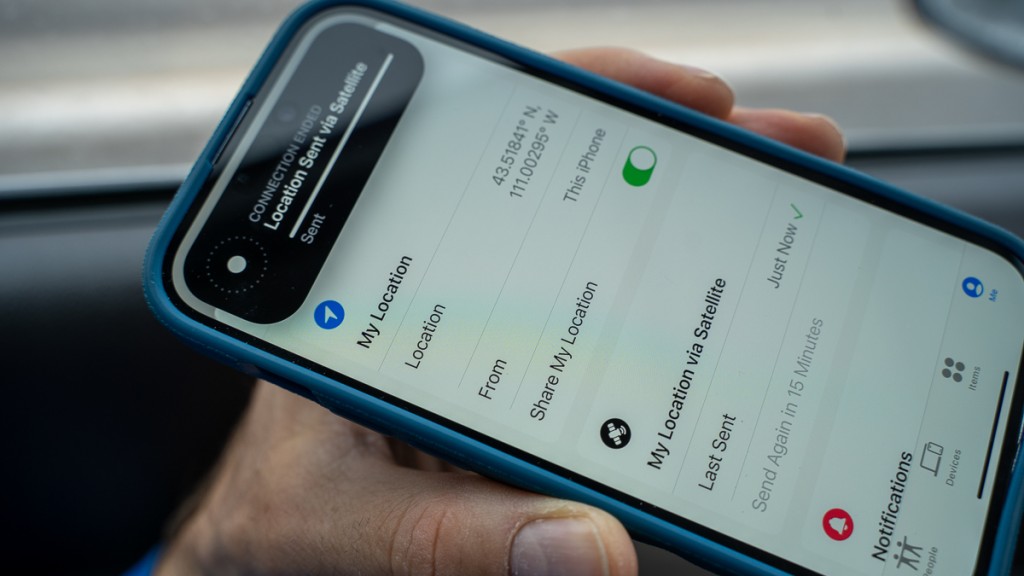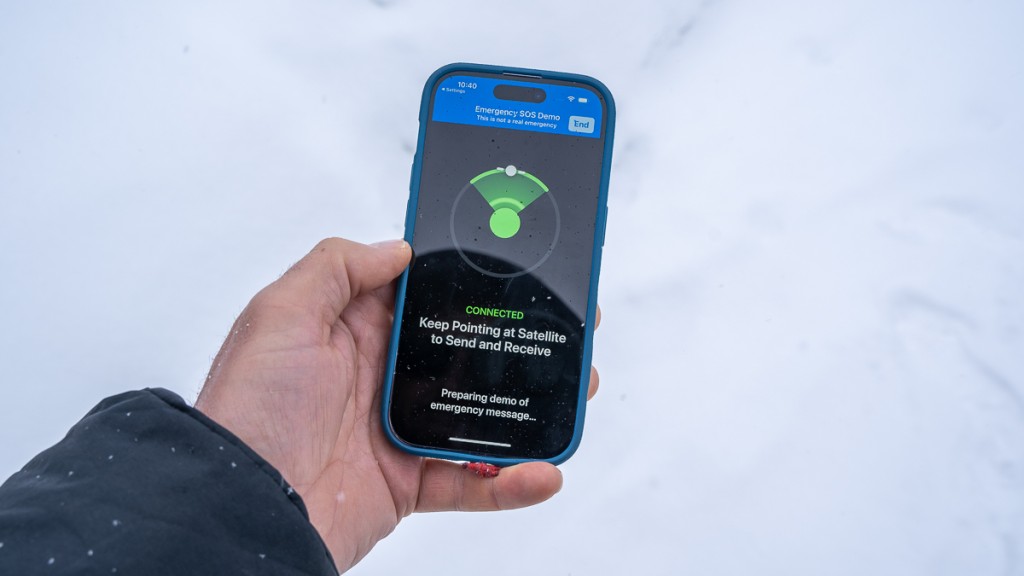iPhone Emergency SOS Review
Our Verdict
Compare to Similar Products
 This Product
iPhone Emergency SOS | |||||
|---|---|---|---|---|---|
| Awards | |||||
| Price | $999 List | Check Price at Backcountry Compare at 3 sellers | $199.95 at REI Compare at 2 sellers | $280 List | $359.95 at REI Compare at 2 sellers |
Overall Score  |
|||||
| Star Rating | |||||
| Bottom Line | A whole new cohort of consumers now has access to satellite communications but it's not a perfect system | There are devices that have more features but those features are unnecessary and come at the cost of more useful function | A compact, full service satellite messenger that has all you need, and is close to all you would want | A small, basic device that employs established network, dispatch, and hardware systems through affordable subscription plans | A small, satellite-linked emergency communicator that is exactly what you need and nothing more |
| Rating Categories | iPhone Emergency SOS | Garmin inReach Mess... | ACR Bivy Stick | Somewear Global Hot... | Ocean Signal rescue... |
| SOS/Emergency Messaging (30%) | |||||
| Non-Emergency Messaging (25%) | |||||
| Signal Coverage (20%) | |||||
| Ease of Use (15%) | |||||
| Portability (10%) | |||||
| Specs | iPhone Emergency SOS | Garmin inReach Mess... | ACR Bivy Stick | Somewear Global Hot... | Ocean Signal rescue... |
| 2-way Messaging? | No | Yes | Yes | Yes | No |
| 2-way Messaging Available via Cellular/Wifi? | Yes | Yes | No | Yes | No |
| Custom Messaging Viewable and Composable on Device? | Yes | Yes | No | No | No |
| Passive Tracking (turn on and forget about it - viewers at home can watch your progress on the web) | No | Yes | Yes | Yes | No |
| Weight w/ Batteries | 7.3 oz | 4.0 oz | 3.6 oz | 4.1 oz | 4.0 oz |
| Battery Life | Depends on other phone usage | Up to 28 days with a message or location sent every 10 minutes with full sky view | Up to 120 hours | Up to 1000 messages | 24 hours |
| Waterproof Rating | IP68 (protection from harmful dust. Rain, splashing, and accidental submersion at least 30 minutes) | IPX7 (No dust rating. Rain, splashing, and accidental submersion up to 30 minutes) | IP67 (protection from harmful dust. Rain, splashing, and accidental submersion up to 30 minutes) | IPX7 (No dust rating. Rain, splashing, and accidental submersion up to 30 minutes) | No Formal Rating. Likely exceeds rating system. Claimed "Up to 15 meters" |
| Pairs with Smartphone? | Yes | Yes | Yes | Yes | No |
| Requires recipient to use a special app for two-way communications? | N/A | No | Yes | Yes | N/A |
| On Device Functions (if you lose or disable your smartphone) | All function is on phone | All, but very slow to text | SOS, check-in, tracking. All texting requires smartphone. | SOS. All texting requires smartphone app | All. |
| Satellite Network | Globalstar | Iridium | Iridium | Iridium | COSPAS/SARSAT |
| Dispatch service | Apple | Garmin Response Team | Global Rescue | GEOS | COSPAS/SARSAT |
| Dimensions | 5.8" x 2.8" x 0.3" | 3.1" x 2.5" x 0.9" | 1.9" x .9" x 4.5" | 3" x 3.6" x .8" | 3.0" x 2.0" x 1.3" |
| Volume | 4.9 CU IN | 6.9 CU IN | 7.7 CU IN | 8.6 CU IN | 6.8 CU IN |
Our Analysis and Test Results
With the "Emergency SOS" satellite service on the iPhone 14 models, Apple brings, for the first time, satellite communication to your ever-present smartphone. The same phone you carry to take pictures and navigate to the trailhead will now provide emergency satellite communications (with all the same caveats of other satellite communication options) and very rudimentary non-emergency messaging. It works and is worth considering when you purchase your next new smartphone.
Performance Comparison
SOS/Emergency Message
The Satellite Emergency SOS feature on the newest Apple iPhones is the biggest change they've rolled out in a while. Technologically, the iPhone 14 SOS messaging is the same as what has long been available in products from other manufacturers in our review. Apple uses the same satellites (with the same coverage and timing limitations) as others. Built into a smartphone, though, the interface is inherently smoother and more intuitive to use.
In an emergency, you simply dial 911 regardless of what the top of your phone screen might say about cell coverage (in the US and Canada, which is where this satellite SOS option is first available — as it rolls out to other countries, you will dial the local emergency number in that country). 911 calls tap into a greater cell coverage network than your regular service plan will. If your phone can get a cellular signal of any type, it will connect the 911 call like normal. If it cannot connect to a cellular tower, it will automatically initiate the satellite Emergency SOS protocol. That protocol usually involves you entering a few details about your emergency and then sharing a series of text-only messages back and forth with the dispatch center. Satellite messages (regardless of the device) take longer than regular texts (especially in densely forested or very steep terrain --satellite coverage isn't fully comprehensive, even within the stated coverage area, and this is true of all devices) and, of course, the actual response to your emergency will depend a great deal on local terrain, weather, other emergencies, and search and rescue resources/infrastructure. "Instant," ubiquitous communication coverage is just the first step in getting actual help to your location. That communication is all that the new iPhone technology accomplishes.
Non-Emergency Messaging
Promotional materials for the satellite functionality of the Apple iPhone 14 models focus mainly on emergency functionality. However, there is one seemingly small (but potentially very useful) feature that can serve to relay crucial non-emergency information. Using Apple's Find My app and network, you can manually send your location via satellite to contact(s) out in civilization. The Find My app is a tool used to locate various Apple devices. Many use it to keep tabs on their family members, luggage, car keys, etc. Location of all those things requires cell or wifi signal, and such tracking is mostly done passively. Someone can watch the location of a loved one after initial setup. Within the app, on the iPhone 14 models, users now have the option to manually send a location without cell signal to the same individual or group of pre-arranged contacts. It all needs to be set up beforehand, both technologically and in terms of what such a location message means.
Our lead test editor uses it this way. He works a great deal in the wilderness. He generally has dedicated satellite communications with him and uses the dedicated satellite device for both emergency and routine comms. Now, for him (within the US and Canada), the iPhone 14 serves as a backup for emergency communication. Also, he and his wife use the "Find My" satellite location service as a backup to their routine communication protocol. At the minimum, he is in the habit of sending a daily message that says something like, "I'm in camp for the night and all is well". If, for whatever reason, it seems that that sort of message, via a dedicated device, is not getting through to his wife, he now sends a location via satellite and the Find My app. His wife is conditioned to check that app if communication seems sparse. Seeing that he was able to send that manual message reassures her that he is ok and on track. She cannot respond within the Find My app, and he is unable to add any specific details, but she at least knows where he is and that he is capable of activating that functionality. It adds peace of mind for all involved. You and your contacts can come up with your own protocol and expectations around what these satellite Find My locations mean.
Signal Coverage
Apple uses the GlobalStar satellite network for the iPhone 14 SOS functionality. This is the same network that one of the longest-running companies in the outdoor communication game uses. GlobalStar offers coverage throughout all low to moderate latitudes (below 62 degrees). Technologically, Apple Satellite SOS could work anywhere there is GlobalStar coverage (within normal satellite communication limitations). However, logistically, emergency response is locally administered. Because of this, Apple Satellite SOS is only available in approved areas. Coverage for US and Canada rolled out in November of 2022. We tested in Southern Argentina in December of 2022. We were in a location with GlobalStar coverage, but the "SOS" icon on the iPhone was not visible. Nor was the demo mode or Find My satellite location service. Testing of other devices employing GlobalStar in Alaska has indicated some functionality, but GlobalStar calls that coverage "marginal" at best.
Ease of Use
Like all mass market, well-developed smartphone apps, the user interface for Apple's iPhone 14 satellite SOS function is slick and easy. That said, it is a technical product and has limitations, so some user understanding is necessary. But Apple, in our experience, makes that process easier than most.
Portability
The smallest iPhone 14 is definitely bigger and heavier than the smallest satellite messengers. Those smaller satellite messengers (many more than half the weight and size of an iPhone) also do more in terms of satellite communication than the iPhone 14. In simple terms, the iPhone is very big and heavy for satellite communications. However, you will likely have a smartphone with you anyway. Who, really, "in this day and age," leaves their smartphone at home while out hiking? If you will carry your smartphone anyway, the iPhone 14 satellite functionality adds absolutely nothing to the weight and bulk of your kit. We didn't give it the highest portability score because of its weight and bulk, but that isn't really the whole story.
Should You Buy the Apple iPhone 14?
Yes, if…
If you are ready to upgrade your smartphone anyway, the satellite communication functionality of the iPhone 14 should factor into your decision. If you already have a satellite communication device or will get one for its two-way wilderness messaging, that choice is harder. If you are a casual outdoors person "on the fence" about satellite communications and the associated investment, the iPhone 14 is a great intermediate step.
What Other Satellite Messengers Should You Consider?
Nothing else, currently, is like the iPhone 14. With it, you get emergency (and rudimentary non-emergency) messaging "off the grid" and with no extra electronics to carry (or subscribe to, for now — Apple has indicated that Emergency SOS will be free "for two years"). In the past, on the most remote trips, members of our test team would carry a smartphone, a primary 2-way satellite messenger like the Garmin inReach Messenger, and a compact emergency-only device like the Ocean Signal rescueME PLB1. With an iPhone 14 in the group, the OceanSignal device can be omitted while maintaining communication redundancy. If you wish to use just the iPhone 14 for wilderness communications, make sure your contacts at home have a good understanding of the realities of such communication. If you want a routine, two-way connection to the outside world, you need something like the inReach Messenger or ACR Bivy Stick.
















